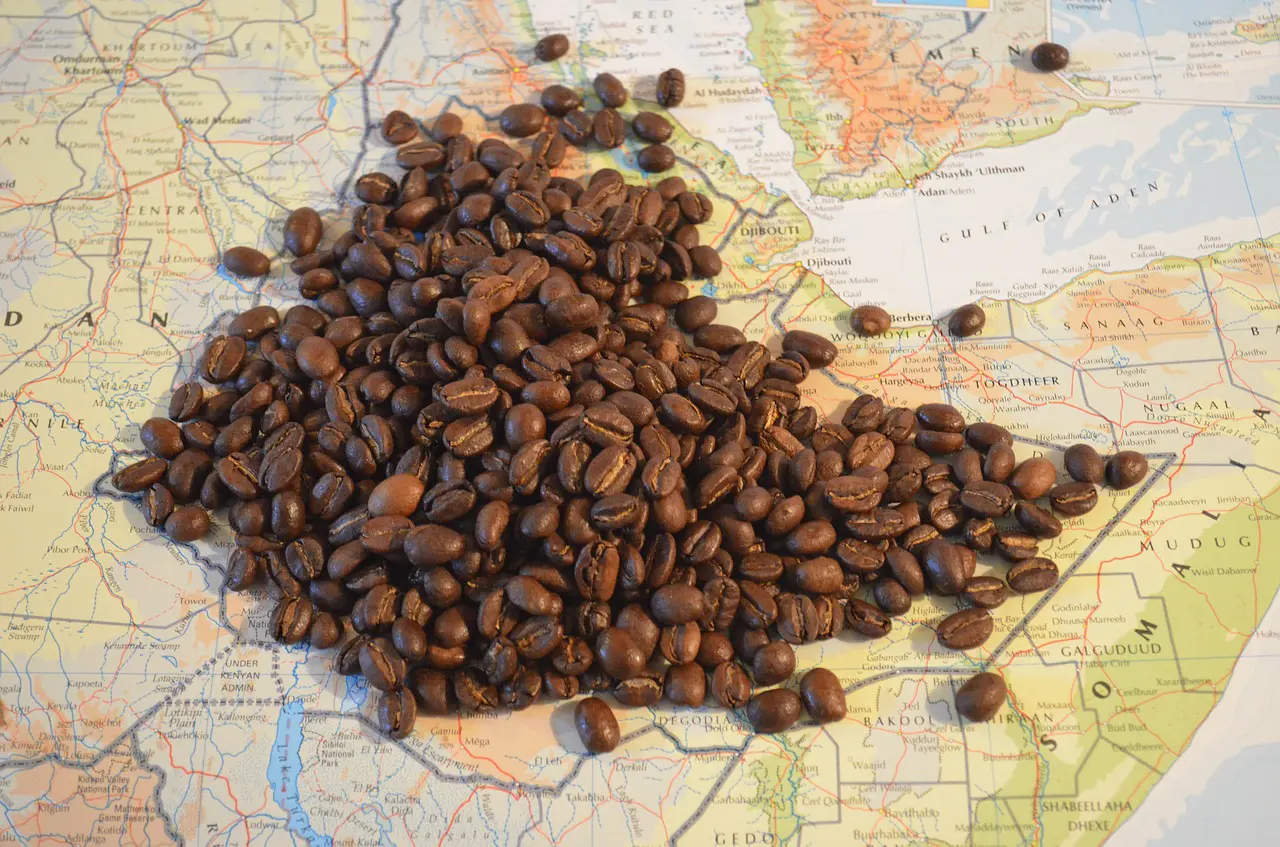Coffee is a brewed drink, prepared from roasted coffee beans. Although coffee has been around for centuries, many people do not know where did coffee originate. Coffee’s origins can be traced back to the plains of Ethiopia, and this is supposedly where Coffee’s origins began. The form of Coffee has changed throughout the years, with coffee berries first being eaten directly from the plant source.
How Was Coffee Discovered? – Ethiopia And The Dancing Goats
Coffee’s humble origins began when an Ethiopian Prince called Kaldi, who noticed the strange ways his goats were acting after consuming some mysterious berries from a bush that he didn’t recognize.
His goats were jumping and dancing and generally acting more boisterous than usual.
Curious to find out as to why this was Kaldi tried the berries himself and was surprised to find out he experienced a surge of energy. Upon this discovery, Kaldi returned home and announced his discovery to his wife who urged him to take the berries to a monastery, which he did and gave the berries.
Initially, the monk described the berries as ‘Devils Work.’ But after a time the berries were burnt, their aroma attracting the attention of the other monks at the monastery and that night they all enjoyed drinking the Coffee. Vowing to drink it every day to keep them awake long into the night.
The tale is supposed to have taken place in 850 AD, and while we can’t say for sure if it’s accurate or not, it’s a fun story nonetheless.
Coffee’s Journey From the Middle East To Europe
Prince Kaldi’s story is not the only tale about the origin of Coffee, a mystic named Ghothul Akbar Nooruddin Abu al-Hasan al-Shadhili from Yemen is said to have spotted berry-eating birds flying over his village unusually energetically. He found some of these berries and also found himself feeling unusually alert after consuming the berries.
There are numerous different tales of how Coffee originated, and whatever the real origin story, Coffee would go on to cause somewhat of a social revolution.
From 1475, the first coffee shops began appearing. They became lively hotspots to have discussions and political debates.
From 1570 coffee began to arrive in Venice, and this was when Coffee started its journey of international trade. At first, Coffee was only available to the very wealthy, but from this point, it began to spread worldwide.
Today, there are over 25 million people employed in the coffee industry worldwide, these 25 million people produce over 9.3 million tonnes of coffee beans each year, this results in over 500 Billion cups of Coffee being consumed each year. So, it’s safe to say Coffee plays a significant role in the modern world; so much so, that it’s become the second most traded commodity in the world after oil.
Into The West – Coffee Invades Europe
Dates can vary on the exact year that Europe spread over Europe. In 1645 however, the first coffee house opened in Italy. This lead to coffeehouses springing up all over Italy. Coffeehouses soon became a cultural hub for people of all walks of life, particularly students and artists.
Coffee houses began to spring up all over Europe, the first coffee house in England opened in 1652.
In 1660, merchants from the French city of Marseilles who had experienced coffee first hand and begun to love the beverage started to import coffee into the city from Istanbul, to match the growing desire and demand for the drink.
The introduction of coffee into Europe did not go without an element of resistance, however. In 1615 it was condemned by the local clergy, the controversy reaching such heights that Pope Clementine VIII himself was asked to intervene.
He was asked to try the drink and found it so satisfying that he gave it Papal approval. That’s not a bad way to get an endorsement!
Like what had occurred in Venice, coffee houses began to spring up all over the city, drawing people from all walks of life to socialize and discuss the daily goings-on.
Coffee Meets Royalty
After the success of coffee in Marseilles, it wasn’t long before it found its way onto the streets of Paris.
By 1669 Coffee had been introduced to Paris by Suleyman Aga, the ambassador to the court of the French King Lous XIV. Now coffee had found its way into royal hands; coffee was described as a magical beverage when mixed with a small number of cloves, cardamom seeds, and sugar. Aga became the darling of Parisian society.
Coffee also began to spread further east into Austria and Eastern Europe. The first coffee house opened in Vienna in 1683. Coffee had been recovered from the collated supplies that the Austrians had gathered from the defeated Turks after the Battle Of Vienna.

It was at this time that sugar and milk also began to be introduced to coffee. A Polish Military officer named Jerzy Franciszek Kulczycki received coffee beans after the battle and went on to open a coffee house in the city, and it was he who introduced sugar and milk to his coffee.
European society would never be the same again. By the mid 17th Century there were over 300 coffee houses in London alone.
Coffee Is Introduced To The Americas
By the mid-1600s Coffee had made it’s way to the new world and had been brought to New Amsterdam, which would later be known as New York.
Coffee houses were popular, but they exploded in 1773 when America’s coffee culture was changed forever, this change was instigated by the Boston Party. A mass revolt against King George III generated a mass switch from the consumption of Tea to Coffee among the colonists.
By the 18th Century, Coffee’s popularity had continued to surge worldwide. Consumption of Coffee in the US continued to increase, causing businessman to begin circling and to begin coming with ways to profit from coffees success.
The late 18th Century marked the dawn of many household coffee companies. In 1864 two brothers born in Pittsburgh; John and Charles Arbuckle began selling pre-roasted Coffee by the pound. Other companies followed suit, and names such as Maxwell House and Hills Brothers sprang up.
The Starbucks Revolution
Founded in Seattle by three partners who had met when they were students at the University of San Francisco, the first Starbucks opened in Seattle, Washington on March 31, 1971. The Coffee industry would never be the same again. The founders Jerry Baldwin, Zev Siegl and Gordon Bowker, had been inspired to start selling high-quality coffee beans and equipment by Coffee roasting entrepreneur Alfred Peet after he had taught them his style of roasting.
By 1968 Starbucks had grown to have six stores in Seattle alone and began selling Espresso Coffee. In 1987 the original owners sold the Starbucks chain to its former manager Howard Schultz., who then rebranded his existing Coffee shops like Starbucks. By 1989 Starbucks was roasting over 2,000,000 pounds of Coffee. Impressive for a company that had been in business for less than twenty years.

Of course, Starbucks has now become a worldwide chain and one of the most recognizable brands; you’ll see a Starbucks in any major city across the globe. The first Starbucks store to operate outside the US was opened in Tokyo, Japan in 1996, quickly followed by a store opening in the Philippines in 1997.
Today there are over 15,000 Starbucks stores worldwide, spanning some 50 countries, and it has gone on onto become the premier roaster and retailer of specialty Coffee worldwide and truly has become the modern-day symbol of Coffee.
History Of Coffee In South America
Coffee first found its way into South America and the Carribean around 1720. First, arriving in Martinique and Haiti, Coffee quickly spread to Mexico and was introduced to Brazil in 1727.
By the midpoint of the 19th century, Brazil had become the largest producer of Coffee in the world, and that paved the way for the expansion of Coffee in South America.
There are many countries in South America, producing very high-quality Coffee. The most famous examples being Brazil and Colombia. Venezuela, Ecuador, and Peru also produce, but these are mostly consumed within their nations rather than exported.
The role of Coffee in the economies and development of South America can’t be overstated with the region being home to the countries that produce the most significant amount of Coffee in the world.
Brazil is still the largest Coffee producing country in the world, with more than one-third of the worlds coffee production. Brazil produces over 20 million bags of Coffee each year, while Colombia is the second largest Coffee producer in South America and the third largest worldwide.
So, it’s safe to say that Coffee is of enormous importance to the economies of South America, and it plays a crucial role in both the economic and social development of these nations.
The Coffee Industry As We Know It TODAY
If you walk past any street corner in any city or town today, and you’ll see an abundance of coffee shops. Coffee has progressed from an exotic newly discovered drink, just a few hundred years ago to now being enjoyed by over 150 million people a day in the US alone.
The coffee industry is worth over $100 Billion worldwide, and the coffee export industry is worth some $20 Billion. Making it the second-most traded commodity in the world, only crude oil being traded more.
There are three main types of coffee bean: 1) Robusta Coffee, 2) Green Coffee 3) Arabic Coffee. Robusta coffee is widely grown across Asia, Western and Central Africa, and Brazil. Brazil meanwhile is the most significant green coffee producer. While Arabica Coffee is more commonly produced in Latin America, Eastern Africa, the Middle East, and Asia.
So, it’s clear that coffee is vital to the economic landscape of many developing nations. Over 90% of coffee production takes place in developing countries, with the top three producers of coffee being Brazil, Vietnam, and Colombia.

Coffee farms provide a livelihood for over 25 million people worldwide, and over 67 percent of all coffee is grown in the Americas alone.
Primarily industrialized nations mainly consume coffee. The top importers of coffee are the US, Germany, France, Italy, Belgium, Spain, Canada, the UK, and Austria. Coffee plays a vital role not only in the development, employment, and economies of developing nations but also in the economies of industrialized countries.
The largest consumers of coffee are mainly European Nations with the Netherlands consuming 260.4 liters per capita, Finland at 184.9 liters per capita and Sweden at 141.9 liters per capita.
The Legacy Of Coffee
It would be naive to paint the picture of Coffee as a wholly positive one although the coffee history is so intriguing. There is a whole debate to be had over whether big coffee companies do enough to make sure that coffee farmers in developing nations are compensated fairly for their output. Major companies such as Starbucks have been involved in various misdemeanors of alleged exploitation of Coffee producers in developing countries.
There’s no denying, however, that Coffee has played a massive role in developing the modern world we live in today and it’s hard to imagine Coffee going anywhere anytime soon. The Coffee industry is said to be growing at a rate of 5.5% each year. The nations seeing the most profitable growth from Coffee are China, Panama, Kenya, Senegal, and the US.
While there are initiatives to protect the rights of Coffee workers worldwide, it has been argued that more needs to be done to protect the people who produce Coffee, but also to protect the environment.
Many initiatives have been put in place aimed at helping producers in developing nations. The Fairtrade institutional arrangement aims at providing producers with better trading conditions. Fairtrade currently works with around 795,000 coffee farmers across 30 countries, and these initiatives are vital for the long term protection of coffee workers worldwide.
The legacy of Coffee is one that has helped shape our modern world, and without it, the landscape of the world would look very different. While many of us will continue to enjoy our Coffee, we should always look for ways to increase sustainability and keep programs and initiatives alive to help the producers of the drink that we all love so much!

Hi my name is Larry, a coffee aficionado from the US. I have already visited Colombia, Sumatra, Guatemala, Costa Rica, Ethiopia and Jamaica in my pursuit of finding the best-tasting coffee beans. I currently write from Bali and enjoy the relaxed life that you can only find in Canggu. Welcome to my coffee world!





